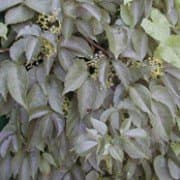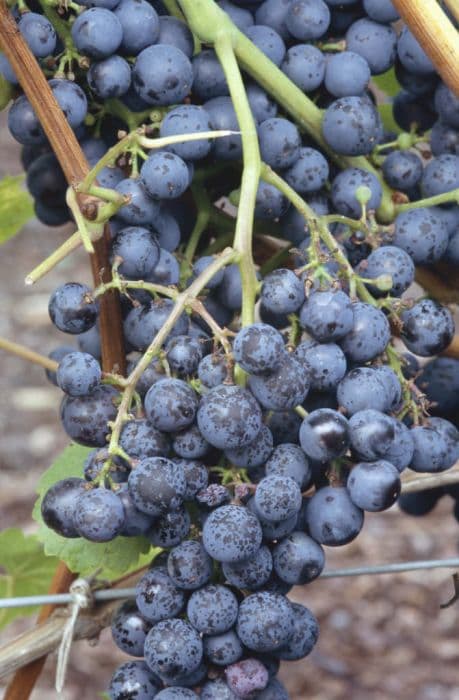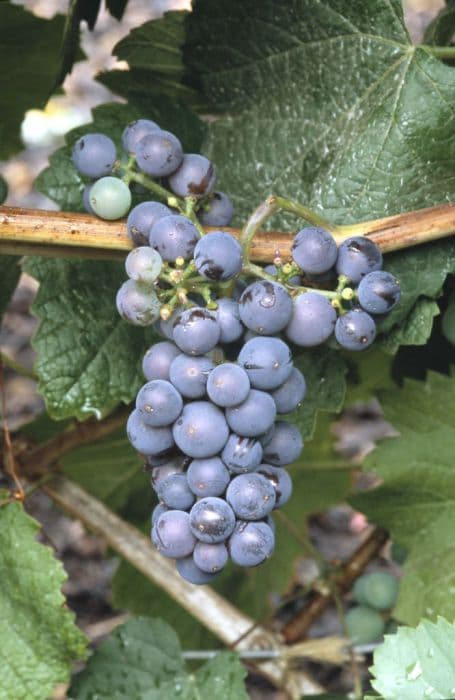Claret Cloak Vine Vitis Claret Cloak = 'Frovit'
![grape [Claret Cloak]](/_next/image?url=https%3A%2F%2Fplants-admin.emdemapps.com%2Fimages%2Fplants%2F%2Fimages%2F604b602abe2f8.png&w=3840&q=75)
ABOUT
Vitis Claret Cloak, commonly known as Vitis 'Frovit', is a visually striking vine known for its ornamental qualities primarily due to its foliage and fruit. The plant's leaves are its most prominent feature, which change colors throughout the seasons. During spring and summer, the foliage takes on a vibrant green hue, creating a lush backdrop for other plants. As the seasons progress, particularly in the fall, the leaves undergo a dramatic transformation. They adopt a deep red or a claret color, justifying the name "Claret Cloak". This rich autumnal palette can add a touch of warmth and color to any garden space, making it a popular choice among gardeners looking to inject seasonal interest. In addition to its colorful foliage, Vitis 'Frovit' produces small clusters of grapes. The grapes can range in color, but they are typically not as prominent as the foliage and are more of an added bonus to the plant's decorative appeal. These fruits may attract wildlife, bringing birds and perhaps other animals into the garden. The vine itself grows in a twining fashion, often seeking out supports to clamber up. It can attach to various structures such as trellises, fences, or walls, making it a versatile choice for vertical gardening and adding height to planting designs. The visual appeal of Vitis 'Frovit' is rounded off by its hardiness and adaptability, which allow it to thrive in a variety of conditions, yet its exact growth habit and vigor, which remain unaddressed here, contribute significantly to its overall appearance in the landscape. Overall, Vitis 'Frovit' offers a dynamic combination of eye-catching leaves and seasonal fruit that can enhance the aesthetic of any garden environment.
About this plant
 Names
NamesFamily
Vitaceae.
Synonyms
Claret Cloak Vine, Frovit Grape Vine, Ornamental Grape Vine.
Common names
Vitis 'Frovit'
 Toxicity
ToxicityTo humans
The 'Frovit' grape vine, which is a variety of Vitis, is generally considered non-toxic to humans. The fruits, or grapes, are edible and commonly consumed. However, other parts of the grape vine, such as the leaves and stems, are not typically eaten and may cause mild stomach upset if ingested in large quantities. It is important to note that the seeds of grapes can contain small amounts of substances which could be harmful in large amounts, but the risk of poisoning from casual consumption is very low. Ingesting large quantities of grapevine parts other than the fruit may lead to symptoms such as diarrhea, nausea, and vomiting.
To pets
The 'Frovit' grape vine is toxic to pets, particularly dogs and cats. The toxicity primarily relates to the grapes themselves, which can cause severe kidney damage in dogs and possibly in cats, although their sensitivity is less well-documented. Symptoms of grape poisoning in pets may include vomiting, diarrhea, lethargy, abdominal pain, decreased appetite, and signs of kidney failure such as decreased urination, weakness, and increased thirst. In some cases, ingestion of grapes can be fatal, so immediate veterinary care is crucial if a pet is known or suspected to have eaten any part of a grape vine. The mechanism behind the toxicity is not well understood, and there is considerable variability in individual animals' reactions, with some animals exhibiting symptoms after ingesting only a small number of grapes.
 Characteristics
CharacteristicsLife cycle
Perennials
Foliage type
Deciduous
Color of leaves
Green
Height
10 feet (3 meters)
Spread
10 feet (3 meters)
Plant type
Climber
Hardiness zones
7
Native area
Europe
Benefits
 General Benefits
General Benefits- Ornamental Value: Vitis 'Frovit', commonly known as the Claret Cloak grape vine, offers aesthetic appeal with its attractive foliage and often vibrant autumn colors.
- Shade Provision: This vine has the capability to create shaded areas when grown over pergolas or trellises, making it useful for creating cooler, protected spaces in gardens.
- Erosion Control: By establishing a strong root system, Claret Cloak can help stabilize soil and prevent erosion on slopes or banks.
- Habitat Creation: The vine provides shelter and food for various bird species, promoting biodiversity within the garden ecosystem.
- Privacy Screen: When grown on fences or other support structures, Claret Cloak can serve as a green privacy barrier.
- Food Production: While not primarily grown for its fruit, Claret Cloak may produce grapes that can be used in making jellies, juice, or even wine.
 Medical Properties
Medical PropertiesThis plant is not used for medical purposes.
 Air-purifying Qualities
Air-purifying QualitiesThis plant is not specifically known for air purifying qualities.
 Other Uses
Other Uses- Crafting material: The flexible, woody vines can be used for wickerwork, creating items such as baskets and garden trellises.
- Natural dye: The leaves and skins of the fruit can be boiled down to create natural dyes for fabrics and yarns.
- Edible creations: The grape leaves are edible and can be used in culinary dishes like dolmas or as a natural wrap for cheeses and appetizers.
- Garden structure: The vigorous nature of the vine allows it to be trained on arbors and pergolas, providing shade and a lush green aesthetic.
- Erosion control: The extensive root system of the vine helps stabilize soil on slopes and can be used in landscape areas prone to erosion.
- Living screen: When planted in rows or on trellises, the vine can create a dense, leafy screen for privacy in a garden or yard.
- Biofuel source: The plant material, particularly pruned vines and excess leaves, can be converted into biofuels as a renewable energy source.
- Wildlife habitat: The vines provide shelter and nesting sites for various birds, while the grapes serve as a food source for wildlife.
- Sensory gardens: The leaves and the fruits add texture and olfactory elements to sensory gardens designed for therapeutic and educational purposes.
- Seasonal decoration: The cut vines can be used to create decorative wreaths and garlands during the holiday season.
Interesting Facts
 Feng Shui
Feng ShuiThe plant Vitis is not used in Feng Shui practice.
 Zodiac Sign Compitability
Zodiac Sign CompitabilityThe plant Vitis is not used in astrology practice.
 Plant Symbolism
Plant Symbolism- Transformation - The 'Frovit' grapevine, like all grapevines, goes through a significant transformation from bud to fruit, symbolizing change and development.
- Abundance - With their tendency to produce plentiful fruit, grapevines are often associated with abundance and fertility.
- Vitality - The vigor with which the 'Frovit' grapevine grows reflects health, life, and vitality.
- Prosperity - In many cultures, grapevines are a sign of prosperity, due to the value of grapes in commerce, especially in winemaking.
- Intoxication - As grapes are a primary ingredient in wine, grapevines can symbolize the duality of intoxication, both literal and metaphorical, including spiritual bliss or a loss of self-control.
- Rebirth - The perennial nature of the grapevine, dying back and then reviving each year, can symbolize rebirth and renewal.
 Water
WaterThe Vitis 'Claret Cloak', commonly known as the ornamental grape, should be watered deeply to encourage root growth, especially during the first growing season to establish an extensive root system. Once established, it can tolerate some drought conditions but will benefit from additional water during dry spells. Typically, aim to water every 7-10 days, providing approximately 1 to 1.5 gallons per plant during each watering session in the absence of rainfall, adjusting for climate, weather, and soil conditions.
 Light
LightOrnamental grape vines like the Vitis 'Claret Cloak' thrive in full sun to partial shade conditions. Ideally, planting the vine in a location where it receives at least 6 hours of direct sunlight a day will promote vigorous growth and optimal foliage color. A spot that offers morning sunlight and some afternoon shelter is beneficial in areas with very hot summers.
 Temperature
TemperatureThe ornamental grape, Vitis 'Claret Cloak', can withstand a range of temperatures but grows best when the climate is between 60°F and 85°F. It's hardy and can survive in temperatures as low as 10°F but should be protected from prolonged exposure to extreme cold. It prefers a site that doesn't drop below 25°F to 30°F during the winter months.
 Pruning
PruningPruning is essential to maintain the health and shape of the Vitis 'Claret Cloak' ornamental grape. Prune the plant in late winter to early spring before new growth starts. Remove dead or damaged wood, and thin out dense areas to allow light and air to penetrate the canopy. The best time for major structural pruning is late winter, but light pruning can be done throughout the year to keep the vine at the desired size and shape.
 Cleaning
CleaningAs needed
 Soil
SoilGrape 'Claret Cloak' thrives best in a well-draining, loamy soil mixed with compost and peat for nutrients and moisture retention. The ideal soil pH for this plant should be slightly acidic to neutral, ranging from pH 5.5 to 7.0.
 Repotting
RepottingGrape 'Claret Cloak' doesn't typically require frequent repotting as it is generally grown outdoors. In containers, it may need repotting every 2-3 years or when rootbound.
 Humidity & Misting
Humidity & MistingGrape 'Claret Cloak' is tolerant of a wide range of humidity levels but prefers moderate to high humidity, without the need for specific humidity adjustments.
 Suitable locations
Suitable locationsIndoor
Provide full sun, well-draining soil, and a sturdy support.
Outdoor
Choose sunny spot, train on trellis, ensure well-drained soil.
Hardiness zone
5-9 USDA
 Life cycle
Life cycleThe life cycle of Vitis 'Claret Cloak', commonly known as grapevine, begins with seed germination, although many cultivated varieties are propagated through cuttings. Once planted, the grapevine enters a stage of vegetative growth where it develops a strong root system and vine structure. As the plant matures, it will undergo a period of budding and leaf development in the spring. This is followed by flowering and subsequent pollination, leading to the development of grape clusters over the summer. The grapes reach full maturity by late summer to early fall, at which point they can be harvested. After harvesting, the vine enters a period of dormancy during the cooler months, conserving energy for the following growing season.
 Propogation
PropogationPropogation time
Spring-Early Summer
Propogation: The Vitis 'Claret Cloak', commonly known as a variety of grapevine, is primarily propagated through hardwood cuttings, a method that is both popular and effective for this type of plant. To propagate 'Claret Cloak' grapevines by hardwood cuttings, one should select mature, well-ripened canes from the current year's growth during the dormant season, generally late winter. The cuttings should be about 12 to 18 inches (30 to 45 centimeters) long and contain 3-4 buds. One should plant the cuttings in well-draining soil, burying two-thirds of the cutting's length into the ground and ensuring the topmost bud is just above the soil surface. Maintaining consistent moisture without over-saturating the soil is crucial for successful root development.









